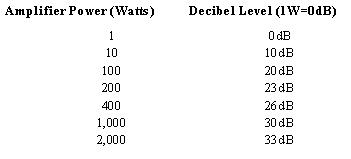A unit of measurement used to indicate audio power level, literally one-tenth of a bel, where the bel is a power ratio of 10:1. Technically, a decibel is a logarithmic ratio of two power measurements, which means that there is no such thing as a dB measurement in isolation. In order to measure a signal in dB, you need to know what power (watts, volts) it is referenced to and the impedance of the reference system.
Number of dBs = 10 log (P1/P2),
where P1 and P2 are the two powers being compared, and where the log is base-10. Imprecisely, 1dB is the smallest increment in loudness detectable by a careful listener. An increase of about 3dB is a doubling of electrical (or signal) power; an increase of 10dB is ten times more power, but is only a doubling of perceived loudness. Some commonly used power ra-tios, expressed in dB:

However,
Number of dBs = 20 log (V1/V2),
where V1 and V2 are the two voltages being compared, and where the log is base-10. This means that the answer is twice what it would be for a ratio of powers. In other words, dou-ble the voltage and the level goes up by 6dB; halve the voltage and the level goes down by 6dB. See Appendix A.

